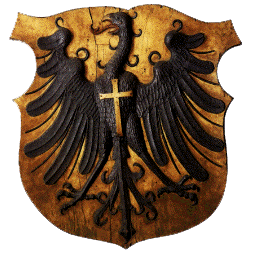The Territory of the Reichsstadt Rottweil.
Some general remarks
The city Rottweil was an independent imperial town within the Holy Roman Empire of German Nation ("Frei- und Reichsstadt") until 1802 and had no other souvereign than the Emperor. It had a small, however, non-coherent territory of up to 30 villages (at the same time) around it.
For various reasons (see below) is not always easy to determine exactly the borders of the Reichsstadt Rottweil during the centuries (for some figures have a look at the following pages).

In mideval times the souvereignity over a village could be in the hands of a Reichsstadt, a noble, a clerical or secular institution or even a private person. It could even be shared with another sovereign, institution, noble or private person. The souvereignity over a village meant that certain taxes had to be paid, often it included compulsory labors and military services, and usually the "lower" jurisdiction which was quite lucrative because the fines for minor delicts had to be paid to the souvereign(s) of a village.
The tithe was usually in possession of a different clerical or secular institution, noble or a private person. It was often, if not usually, divided into several parts. The yield of a tithe heavily depended on the harvest and was often given to a person or institution for a fixum of money who then had to take over the risk.
The farms in a village were normally "Lehenhöfe" (fief farms) which were owned again by quite different persons (nobles or private persons) or institutions (mostly churches or cloisters). The farmers had to pay a yearly ground-rent (corn, animals and/or money) which was independent from the yearly crop. In case of a harvest failure, this could be an heavy burden for the farmer. At the end of the mideval, the farms gradually became "Erblehenhöfe" (hereditary fief farms) which means that the farms were left from the father to the youngest son. However, the fiefs could even be sold to third persons, if the patron agreed. The patrons were not so much interested anymore in the ownership and who actually managed the farm, but much more in a steady yearly income.
Only very few farms were owned by the farmers themselves. To make it even more complicated, the patronage over a fief farm was often shared among several institutions or persons, and the fief farm itself could be divided among several farmers, however, one of them had to be the "Lehenträger" (formal vasall) who had to collect the the ground-rent from his co-farmers and to deliver it to the patron(s). Most fief farms were also heavily indebted and the farmers had to pay hefty interests to institutions or persons who had lent the money.
The farmers could be free persons or serfs ("Leibeigene") of patrons who even had no ownerships about the farms of these people. The bondage could also be owned by more than one person or institution. The bondage ("Leibeigenschaft") was left from the mother to her children; that means when a free man married a bondage woman the children were in bondage of the patron of the mother. If a bondage man married a free woman the children were also free. In the territory of the Reichsstadt Rottweil the bondage was not very harsh. The bondage folks had to pay a hen ("Leibhenne") per year to the patron.
Perhaps it becomes clear now when one considers this complicated ownerships in a mideval village that it is not always easy to tell with few words who "owned" a village, the tithe, a farm or its people.
The territority of the Reichsstadt Rottweil included up to about 30 villages, some of them were formally owned by the nearby women cloister Rottenmünster, and/or were only temporarily owned by the Reichsstadt.
|

